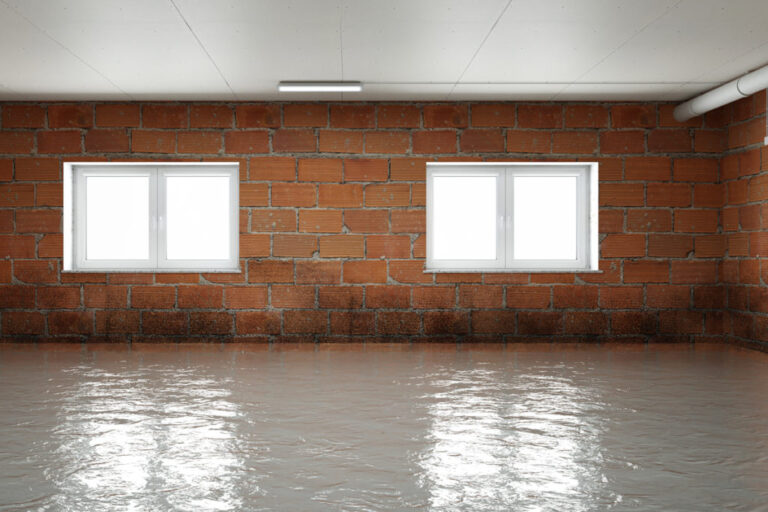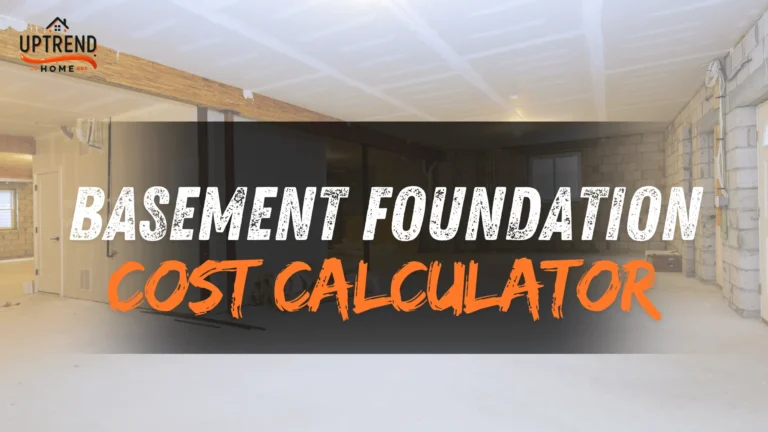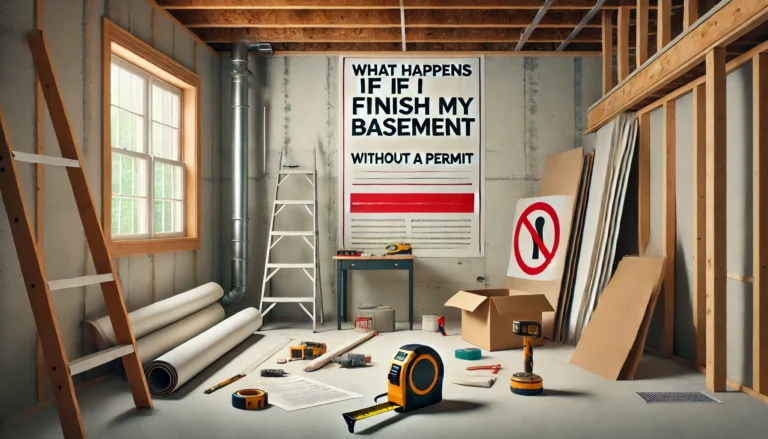How to Get Rid of Musty Smells in Your Basement | Simple and Effective Tips

Understanding Musty Basement Smells: What Causes Them?
Musty smells in basements are more than just an unpleasant nuisance—they can also be a sign of underlying issues that need attention. Understanding the causes of these odors is the first step toward eliminating them for good. Let’s explore the science behind these musty smells and identify the common culprits lurking in your basement.
The Science Behind Musty Smells
Musty odors, often described as a basement mildew smell, are typically caused by mold, mildew, and other fungi that thrive in damp, poorly ventilated environments. When moisture accumulates in a basement, it creates the perfect breeding ground for these microorganisms. As they grow, they release spores into the air, which produce that distinct musty smell. The longer the moisture persists, the stronger the odor will become.
In basements with additional features like a Basement Kitchenette, the combination of moisture and organic materials can worsen the problem, making it crucial to address both the humidity and ventilation. In addition to mold and mildew, other bacteria can also contribute to musty smells. These microbes feed on organic materials like wood, drywall, and fabric, which are often present in basements, further intensifying the stench. The key to eliminating the smell lies in removing the source of moisture and improving ventilation.
Common Basement Odor Culprits
- Mold and Mildew: The primary cause of musty smells in basements is the growth of mold and mildew. These fungi thrive in areas with excessive moisture, such as damp corners, behind furniture, and in hidden spaces like crawl spaces. If your basement smells like mildew or you notice visible mold patches, it’s likely time to address the moisture source.
- Water Leaks: Basements are particularly susceptible to water leaks, whether from outside rainfall, plumbing issues, or groundwater seepage. When water enters your basement and isn’t properly dealt with, it creates a damp environment that encourages the growth of mold and mildew. In this case, the how to get rid of basement smell comes down to fixing leaks and controlling humidity.
- Poor Ventilation: Inadequate air circulation can exacerbate moisture issues and contribute to the musty smell. Without proper airflow, the dampness lingers longer, allowing mold spores to thrive. It’s essential to know how to get rid of musty smell in basement spaces by increasing ventilation.
- Standing Water: Accumulating water from leaks, heavy rain, or condensation can create stagnant pools that fuel the growth of mold. Even small amounts of standing water can lead to a persistent musty odor if not addressed quickly. Be sure to check your basement often for signs of moisture buildup.
- Old, Wet Fabrics: Damp carpets, old clothing, or upholstery that has been exposed to water can absorb moisture and develop a musty smell over time. Even when these materials seem dry, they can still harbor bacteria and fungi, continuing to produce the odor. Consider deep cleaning or removing any water-damaged fabrics to help eliminate the musty smell.
By understanding these common causes, you’ll be better equipped to eliminate the source of the musty smell and prevent it from returning. Whether you are dealing with a basement mildew smell or how to remove musty smell from the basement, taking action to remove moisture and improve airflow is essential. Next, we’ll explore effective ways to remove those odors and keep your basement smelling fresh.
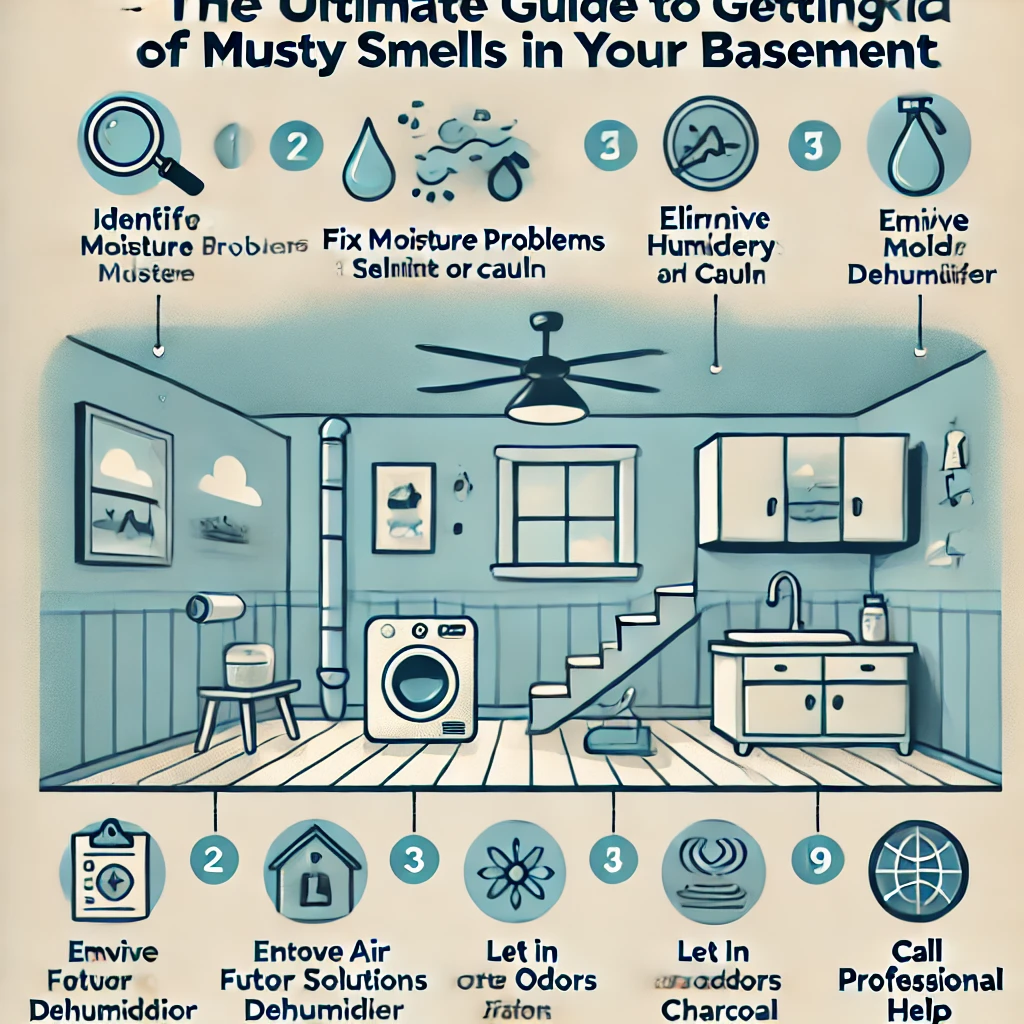
Step 1: Identifying the Source of the Musty Odor
Before you can effectively get rid of the musty smell in your basement, you need to pinpoint the source of the odor. The key to eliminating any basement mildew smell or musty odor is identifying the root cause, whether it’s mold, water leakage, or poor ventilation. Once you understand where the moisture is coming from, you can take targeted steps to eliminate it.
How to Detect Hidden Sources of Dampness
Sometimes, the source of the musty smell isn’t immediately obvious. In many basements, dampness can hide in walls, ceilings, or under flooring. Here’s how you can identify hidden sources of moisture:
- Check for Visible Signs of Mold and Mildew: The most obvious clue that moisture is present is visible mold or mildew. Look for dark patches or fuzzy growth on walls, floors, and ceilings. Mold can appear in many colors, from black to green to white. If you notice any growth, it’s a clear indication of excess moisture in that area.
- Look for Water Stains or Discoloration: Water stains, discoloration, or peeling paint on walls and ceilings are often a sign that moisture has been present for a while. These signs may point to leaks or water infiltration from outside.
- Smell the Air: Often, the musty smell in basement spaces will be strongest in areas where moisture is more concentrated, such as corners, behind furniture, or around pipes. Follow your nose to determine the most affected areas.
- Inspect Windows and Doors: Check for condensation on windows, especially after rain or during the winter months. Poorly sealed windows and doors allow water to seep into your basement, contributing to the musty smell.
- Look for Wet or Damp Spots on the Floor: If your basement is prone to water seepage, wet or damp spots on the floor can be a clear indication of where moisture is entering. Check the floor after a heavy rain to see if there are any puddles or damp patches.
Tools You Can Use to Find the Source
Once you’ve identified the general area where the dampness or musty smell is coming from, you may need to use some tools to detect hidden moisture sources more accurately. Here are some helpful tools:
- Moisture Meter: A moisture meter is an excellent tool for detecting hidden dampness behind walls or under floors. It works by measuring the moisture content in materials like wood, drywall, and concrete. This will help you find areas of excess moisture that may not be visible to the eye.
- Infrared Thermometer: An infrared thermometer can help you detect temperature differences in walls or floors. If there’s a cold spot, it could be a sign that moisture is trapped in that area. This is especially useful for finding leaks or condensation inside walls.
- Dehumidifier: While primarily used to remove moisture, a dehumidifier can also help you determine the level of humidity in your basement. If the air feels damp or clammy, a dehumidifier can help reduce the moisture level, making it easier to detect the source.
- Flashlight: When inspecting dark corners and hidden spaces, a flashlight can be crucial for seeing behind furniture, inside cabinets, or in tight spaces. Use it to check for hidden mold or moisture buildup.
By carefully identifying the source of the musty odor, you can prevent future smells and ensure that your basement stays dry. Whether you’re dealing with a musty smell in basement or how to get rid of mold smell in basement, knowing where the moisture is coming from will make the solution that much easier. Next, we’ll explore how to make the necessary repairs and tackle these odors head-on.
Step 2: Fixing Moisture Problems at the Source
Once you’ve identified the source of the musty smell in your basement, the next crucial step is addressing the moisture problems directly. Whether it’s a crack in the basement walls, a plumbing issue, or groundwater seeping in, fixing these issues will not only eliminate the musty odor but also prevent future problems. Here’s how you can tackle moisture at its source and stop the basement mildew smell once and for all.
Sealing Cracks and Leaks in Basement Walls
Cracks in your basement walls and foundation are a common entry point for moisture. These cracks allow water to seep into the space, leading to increased humidity levels and the growth of mold and mildew. Sealing these cracks is essential for keeping your basement dry.
- Inspect for Cracks and Gaps: Look for visible cracks in the walls or floor, especially around window frames and corners. Small gaps can allow moisture to enter, so it’s important to thoroughly inspect all areas of your basement.
- Use Waterproof Sealant: Once you’ve located the cracks, use a high-quality waterproof sealant or epoxy to fill them. These materials are designed to create a barrier that prevents water from penetrating your basement.
- Apply Foundation Repair Products: For larger cracks or more serious structural damage, you may need foundation repair products like hydraulic cement or polyurethane foam. These products are designed to expand and create a waterproof seal, ensuring that moisture stays out.
Addressing Plumbing Leaks and Condensation Issues
Plumbing leaks and condensation are major contributors to musty smells in the basement. The constant presence of water from leaks or condensation can encourage mold growth, leading to persistent basement odor issues.
- Check Pipes for Leaks: Start by inspecting all visible plumbing pipes for leaks or signs of corrosion. If you notice any drips, rust, or water stains around pipes, you’ll need to repair them immediately.
- Insulate Cold Pipes: Cold water pipes in your basement can accumulate condensation, especially during the summer months. Insulating these pipes helps to prevent moisture buildup and reduces the chances of mildew smell in basement areas. Use foam pipe insulation to cover the pipes and minimize condensation.
- Repair Faulty Sump Pumps: If your basement has a sump pump, ensure that it’s functioning properly. A malfunctioning sump pump can lead to water accumulation, creating the perfect environment for mold growth. Check the pump regularly to ensure it’s clear of debris and working effectively.
Preventing Groundwater from Entering Your Basement
Groundwater is one of the most common culprits behind basement moisture problems. It can seep through your foundation walls and floors, especially after heavy rain or snowmelt. Preventing groundwater from entering your basement is crucial for maintaining a dry and odor-free space.
- Improve Exterior Drainage: Ensure that the ground around your home slopes away from the foundation. Poor exterior drainage can cause water to pool near the foundation, allowing it to seep inside. Adding soil around the perimeter of your home and installing downspout extensions can help redirect water away from the basement.
- Install a French Drain: A French drain is a trench filled with gravel and a perforated pipe that helps divert groundwater away from the foundation. Installing a French drain around your basement can significantly reduce moisture buildup and prevent musty smells caused by water infiltration.
- Seal Your Foundation: In addition to repairing cracks, you can apply a waterproofing membrane to the exterior of your foundation. This membrane creates an additional layer of protection against groundwater seepage, helping to keep your basement dry and odor-free.
By addressing these moisture problems at the source, you can effectively get rid of musty odors in your basement and prevent them from returning. Whether it’s fixing cracks in the walls, repairing plumbing issues, or preventing groundwater from entering, these steps will ensure a dry and fresh basement. Now that you’ve tackled the moisture problems, it’s time to focus on eliminating the musty smell itself.
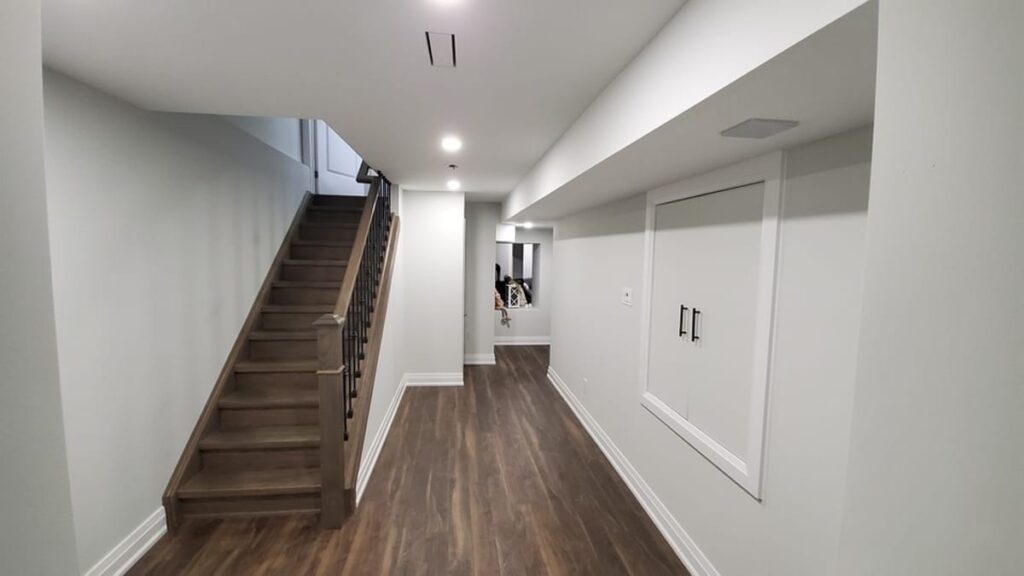
Step 3: Eliminating Mold and Mildew
Mold and mildew are the top culprits behind musty smells in basements. These pesky fungi thrive in damp, poorly ventilated environments, making your basement an ideal breeding ground. Not only do they cause an unpleasant odor, but they can also lead to serious health concerns. Here’s how you can tackle mold and mildew to eliminate that musty smell once and for all.
How Mold and Mildew Contribute to Musty Smells
Mold and mildew both thrive in moist, humid conditions, which is why your basement can easily become a hotspot for their growth. When mold and mildew spores land on a damp surface, they begin to grow and spread, releasing volatile organic compounds (VOCs) as they do. These VOCs are the main source of the musty odor that you’re smelling.
Mold is particularly harmful because it can grow on almost any surface, including wood, drywall, and insulation. Mildew, which is a type of mold, often forms as a thin layer on surfaces like shower tiles and fabrics, contributing to a milder, but still unpleasant, odor. If left unchecked, both can lead to serious damage to your home and even health issues like respiratory problems and allergies.
Safe and Effective Mold Removal Techniques
When it comes to getting rid of mold and mildew in your basement, it’s important to use the right techniques and products to ensure a safe and effective cleanup.
- Wear Protective Gear: Mold removal can release spores into the air, so it’s important to protect yourself. Wear gloves, a mask, and goggles to avoid inhaling spores or having them come into contact with your skin.
- Clean with Natural Solutions: For smaller mold and mildew problems, you can often remove them with natural cleaning solutions like white vinegar or baking soda. Spray white vinegar directly on the affected areas, let it sit for about 15 minutes, and then scrub the surface with a brush. Baking soda can also be sprinkled on moldy areas, then scrubbed with water to create a cleaning paste.
- Use Mold-Killing Products: For more stubborn mold growth, consider using store-bought mold removers that are designed to kill mold and mildew. These products contain ingredients like chlorine bleach or hydrogen peroxide, which effectively eliminate the fungi. Make sure to follow the manufacturer’s instructions for proper use.
- Dry the Area Thoroughly: After cleaning, make sure the area is completely dry. Mold and mildew thrive in damp conditions, so you’ll want to use fans or dehumidifiers to dry the space. This will prevent future mold growth and help eliminate any lingering odors.
- Treat the Area with a Mold Inhibitor: Once you’ve removed the visible mold and mildew, applying a mold inhibitor to the affected area can help prevent future growth. These products create a protective barrier on the surface, discouraging mold from returning.
When to Call a Professional for Mold Issues
While many mold and mildew issues can be handled on your own, there are certain situations where it’s best to call in a professional. If you notice extensive mold growth covering a large area or hidden mold behind walls or under floors, it’s time to seek expert help. Mold remediation professionals have the necessary tools and expertise to safely remove mold and prevent it from returning.
- Large Mold Growth: If mold is covering more than 10 square feet or appears to be spreading rapidly, it may be best to leave the cleanup to professionals. They can assess the extent of the problem and ensure proper removal.
- Hidden Mold: Mold can grow in hidden areas like behind walls or under flooring, where you may not be able to detect it easily. Professionals use advanced equipment, like moisture meters and infrared cameras, to identify hidden mold and moisture sources.
- Health Concerns: If you or your family members are experiencing health issues such as persistent coughing, sneezing, or headaches, it’s essential to have mold removed by a professional to avoid health risks associated with mold exposure.
- Recurring Mold Problems: If mold keeps coming back despite your best efforts, it could be a sign that there’s an underlying issue that needs professional attention. A mold expert can help identify and fix the root cause of the problem, such as inadequate ventilation or persistent moisture.
By following these steps to eliminate mold and mildew, you’ll be well on your way to getting rid of the musty smell in your basement. Whether you choose to tackle the mold yourself or bring in a professional, addressing the mold and mildew problem is crucial for creating a healthy, odor-free basement.
Step 4: Controlling Humidity and Moisture Levels
One of the key contributors to musty smells in basements is excessive humidity. When moisture levels are high, your basement becomes a breeding ground for mold, mildew, and other unpleasant odors. Controlling the humidity and moisture in your basement is crucial for eliminating and preventing musty smells. Let’s explore the best ways to maintain an optimal humidity level in your basement and keep odors at bay.
Using Dehumidifiers to Keep Humidity in Check
A dehumidifier is one of the most effective tools to control moisture levels in your basement. These devices work by drawing in damp air, removing moisture, and releasing dry air back into the room. By using a dehumidifier regularly, you can keep humidity levels under control and reduce the chances of mold growth and that musty odor.
Benefits of Dehumidifiers:
- Prevents Mold and Mildew: Keeping moisture levels below 60% is key to preventing mold and mildew growth. Dehumidifiers can help maintain this ideal humidity level.
- Improves Air Quality: Dry air can reduce the presence of allergens such as dust mites, which thrive in humid environments.
- Protects Your Belongings: By reducing moisture in the air, dehumidifiers help protect furniture, carpets, and other items in your basement from water damage and mold.
When choosing a dehumidifier, it’s important to select one that is appropriately sized for your basement. A small dehumidifier might not be effective in a large basement, while a very powerful one might dry the air too much, making it uncomfortable. Most models have a humidity setting that allows you to maintain an ideal range between 30-50%.
The Importance of Proper Basement Ventilation
Proper ventilation plays a crucial role in controlling moisture in your basement. Without adequate airflow, humid air can become trapped, leading to damp conditions that promote mold and mildew growth. Ventilation helps to circulate fresh air and expel humid, stale air, making it essential for maintaining a healthy environment in your basement.
Ways to Improve Basement Ventilation:
- Install Vents or Windows: If your basement has windows, open them regularly to allow air to circulate. Alternatively, consider installing venting systems that can help draw in fresh air from outside and remove stale air.
- Use Exhaust Fans: Exhaust fans help to remove excess moisture and provide ventilation in areas where natural airflow is limited. Consider installing an exhaust fan in the basement to ensure continuous air movement.
- Attic Ventilation: If your basement is attached to your home’s main structure, check the attic for adequate ventilation. Poor attic ventilation can cause moisture to accumulate in your basement due to the buildup of hot, humid air.
How to Maintain an Optimal Basement Environment Year-Round
Maintaining the right environment in your basement is an ongoing task that requires consistent care. Here’s how to keep humidity and moisture in check year-round:
- Monitor Humidity Levels Regularly: Invest in a hygrometer to track the humidity levels in your basement. This inexpensive device allows you to measure humidity, so you can adjust your dehumidifier or ventilation as needed.
- Insulate Pipes and Walls: Uninsulated pipes in your basement can sweat and release moisture into the air. Insulating pipes can prevent this and reduce humidity.
- Seal Gaps and Cracks: Sealing cracks in walls and floors helps to prevent moisture from seeping in, keeping your basement dry and odor-free.
- Use Moisture-Resistant Paint: Applying moisture-resistant paint to basement walls and floors can help create a barrier that keeps humidity from entering the room.
- Clean Regularly: Regular cleaning, especially in high-moisture areas like around pipes or drains, can help prevent the accumulation of dirt and mildew that contribute to unpleasant odors.
By managing humidity and moisture levels with dehumidifiers, improving ventilation, and maintaining a balanced basement environment, you can greatly reduce the chances of musty smells reappearing in your basement.
Step 5: Deep Cleaning Your Basement
After addressing moisture and mold issues, deep cleaning your basement is essential for eliminating any lingering musty odors and ensuring a fresh, clean environment. Even if you’ve fixed the source of dampness, dust, dirt, and mold spores can still contribute to unpleasant smells. A thorough cleaning routine is vital to prevent odors and maintain a healthy basement space.
The Best Products for Cleaning Basement Surfaces
To effectively clean your basement and get rid of musty odors, it’s important to use the right cleaning products. Here are the best options to help tackle both dirt and mildew buildup:
- Mold and Mildew Removers: Specialized cleaners that target mold and mildew are crucial in getting rid of the musty smell in your basement. Look for products with antifungal agents, such as bleach-based cleaners, that can eliminate mold and mildew at their root.
- All-Purpose Cleaners: A good all-purpose cleaner can be used for cleaning walls, floors, and shelving units. Choose products that contain natural ingredients like vinegar or baking soda, which are known for their deodorizing properties.
- Disinfectants: Disinfectants are essential for cleaning areas that are frequently touched, such as handrails, doorknobs, and other high-traffic surfaces. Opt for disinfectants that are effective against bacteria, mold, and mildew.
- Air Fresheners or Deodorizers: After cleaning, freshen up the space with a deodorizing spray. Natural scents like lavender, citrus, or eucalyptus not only freshen the air but also help eliminate lingering musty odors.
- HEPA Vacuum: For carpeted or rug-covered floors, using a vacuum with a HEPA filter will help trap dust, dirt, and pet dander, preventing them from circulating back into the air.
When cleaning surfaces, use a soft cloth or microfiber mop to avoid scratching walls or floors. For stubborn dirt and mildew buildup, you can use a soft-bristled brush to scrub areas effectively.
How Often Should You Clean to Prevent Odors?
Cleaning your basement regularly is crucial to keep it smelling fresh and prevent odors from returning. The frequency of cleaning depends on the condition of your basement and how often it’s used. Here’s a general guideline for keeping your basement clean and odor-free:
- Quarterly Deep Cleaning: For most basements, deep cleaning every 3 to 6 months is sufficient. This includes wiping down all surfaces, vacuuming carpets, and cleaning vents and air systems.
- Monthly Spot Cleaning: If you notice areas with more dust or mildew growth, it’s a good idea to spot-clean those sections more frequently. This will help prevent mold from spreading or musty smells from developing.
- More Frequent Cleaning in High-Humidity Areas: If you live in an area with high humidity or if your basement is a frequently used living space, consider cleaning once a month. The increased moisture levels can contribute to faster mildew and mold buildup.
By establishing a routine cleaning schedule, you can ensure that your basement remains a fresh, odor-free space. Regularly deep cleaning your basement will not only eliminate existing smells but also prevent the growth of mold and mildew in the future. With the right products and a consistent cleaning schedule, you’ll be well on your way to keeping your basement smelling fresh and pleasant year-round.
Step 6: Natural Solutions to Absorb Musty Odors
If you’re looking for eco-friendly and budget-friendly ways to eliminate musty odors in your basement, natural solutions can be highly effective. These methods not only help absorb and neutralize odors but also improve the overall air quality in your space without harsh chemicals. Let’s dive into the natural solutions that can keep your basement smelling fresh.
Using Baking Soda and Activated Charcoal to Fight Odors
Baking soda and activated charcoal are two of the most reliable natural odor-absorbers. Here’s how they work and how you can use them to your advantage:
- Baking Soda: Known for its ability to neutralize odors, baking soda is a household staple for absorbing musty smells. Simply place an open box or a few small bowls of baking soda around your basement, particularly in areas with higher humidity or where the odor is strongest. Leave them for a couple of days to allow the baking soda to absorb moisture and odors.
- Pro Tip: Sprinkle baking soda on your basement carpets or rugs, let it sit for 15–20 minutes, and then vacuum it up. This will help remove any lingering musty smells trapped in the fibers.
- Activated Charcoal: Activated charcoal is highly effective at absorbing moisture and odors, including mildew and mold smells. You can find activated charcoal in bags or packets, which are perfect for placement in different corners of your basement.
- Pro Tip: Hang bags of activated charcoal near the areas with the strongest odor or place them in storage closets and corners to absorb moisture and fight odors.
Both of these natural solutions work quietly behind the scenes, offering long-lasting results and creating a cleaner, fresher-smelling environment in your basement without any harsh chemicals.
Essential Oils and Natural Fresheners for Basements
Essential oils aren’t just for relaxation—they can also serve as natural air fresheners that help mask musty odors and add a pleasant scent to your basement. Here’s how you can use essential oils and other natural fresheners to improve your basement’s air quality:
- Essential Oils: Essential oils like tea tree oil, lavender, eucalyptus, and lemon are known for their antimicrobial and deodorizing properties. To use them, mix a few drops of your chosen oil with water in a spray bottle and lightly mist the air or surfaces in your basement. Alternatively, you can use a diffuser to circulate the fragrance throughout the room.
- Pro Tip: Add a few drops of tea tree oil or lavender oil to a bowl of water and place it near areas where mold or mildew might be present. This will help neutralize the odor and prevent further growth.
- Citrus Peels: Citrus fruits like oranges, lemons, and limes contain natural oils that can freshen the air and neutralize odors. Simply place fresh peels in bowls around the basement or dry them out and store them in small cloth bags. Not only will this add a refreshing scent, but it will also help absorb moisture from the air.
- Herbs and Spices: Some herbs and spices, such as cinnamon sticks, cloves, and rosemary, can add a pleasant fragrance to your basement. You can create DIY air fresheners by simmering these ingredients on the stove or placing them in decorative bowls throughout the space.
By incorporating these natural solutions, you can effectively absorb and neutralize musty basement smells while maintaining a fresh, healthy atmosphere. These simple yet powerful remedies ensure that your basement remains odor-free without relying on synthetic air fresheners or harsh chemicals.
Step 7: Enhancing Air Circulation in Your Basement
Proper airflow is essential for maintaining a fresh-smelling basement and preventing musty odors. Stagnant air allows moisture to accumulate, creating the perfect environment for mold, mildew, and unwanted smells. By enhancing air circulation, you can not only keep odors at bay but also improve the overall air quality in your basement. Here’s how you can boost airflow effectively without overcrowding your space.
The Role of Fans and Airflow in Odor Prevention
Air circulation plays a crucial role in keeping musty basement smells from becoming a persistent problem. When air flows freely, moisture is dispersed, and the damp environment that encourages mold and mildew growth is minimized. Here are some effective ways to utilize fans and enhance airflow:
- Use Exhaust Fans: Installing exhaust fans in strategic areas of your basement, especially near windows or doors, can help expel moist, stale air while bringing in fresh air from outside. Exhaust fans are particularly useful in preventing humidity buildup and can be left running intermittently to maintain air movement.
- Pro Tip: Consider using a timer for your exhaust fan so it runs during the most humid parts of the day, like after heavy rains or during high humidity seasons.
- Place Box Fans Near Damp Areas: Positioning box fans near areas with high humidity or where you’ve noticed musty smells can help direct airflow towards those spots. Make sure to direct the airflow toward a vent or open window to allow the damp air to escape.
- Use a Ceiling Fan: If your basement has a ceiling, installing a ceiling fan can improve circulation by drawing air upward and distributing it throughout the space. A fan will prevent air from becoming stagnant and help maintain a comfortable atmosphere year-round.
How to Maximize Air Circulation Without Overloading Your Space
While fans are an effective way to enhance airflow, it’s essential to strike the right balance in your basement. Overcrowding the space with too many fans or other airflow devices can lead to noise, inefficient circulation, or even blocking crucial ventilation paths. Here’s how to make the most of the space while ensuring maximum airflow:
- Strategic Fan Placement: Instead of overcrowding the basement with fans, focus on placing them in areas where air is most likely to become trapped, such as corners, behind furniture, or near damp spots. Ensure that the fans face toward the source of moisture or toward a window to direct stale air outside.
- Open Windows and Vents: If your basement has windows or vents, open them when possible to allow for natural ventilation. Proper window placement can help create a cross-breeze that pushes moisture-laden air out of the basement. Even small openings can make a big difference in improving airflow.
- Maintain Pathways for Air: Avoid cluttering up your basement with excessive furniture or stored items. Keeping pathways clear allows the air to circulate more freely. If you have large items or storage units, try to leave space around them for airflow, particularly near vents or windows.
By focusing on effective fan use and maximizing natural airflow, you can greatly reduce musty basement smells and prevent moisture from lingering. These simple adjustments will keep your basement feeling fresh and breathable, making it a more pleasant environment for everyday use.
Step 8: Letting in Fresh Air and Natural Light
Ventilation and sunlight are often overlooked but play a crucial role in eliminating musty smells in your basement. Both natural elements work in tandem to improve air quality, dry out moisture, and prevent the growth of mold and mildew. Here’s how you can harness the power of fresh air and sunlight to create a healthier and fresher basement environment.
The Benefits of Ventilation and Sunlight Exposure
- Fresh Air for Odor Removal: Introducing fresh air into your basement helps dilute musty smells and expels stagnant, damp air that can encourage mold and mildew growth. The constant exchange of air brings in oxygen and disperses harmful moisture, reducing the chances of odors lingering. Ventilation also prevents air from becoming overly humid, which is a prime cause of mustiness in basements.
- Sunlight for Drying: Sunlight acts as a natural disinfectant. When sunlight enters your basement, it helps dry out the moisture in the air and on surfaces, reducing the damp environment that causes unpleasant odors. Plus, sunlight has the added benefit of inhibiting mold and mildew growth, as these fungi thrive in dark, humid areas. Letting in sunlight not only freshens up the basement but also helps protect against future odor issues.
- Healthier Air Quality: Both fresh air and sunlight contribute to better indoor air quality. Natural light boosts mood and energy, while fresh air promotes better breathing conditions by reducing airborne pollutants. This is particularly important in basements, where poor air quality can make the space feel stuffy and uncomfortable.
Best Practices for Ensuring Adequate Fresh Air Flow
Maximizing fresh air and sunlight exposure is key to a fresh-smelling basement, but it’s important to ensure it’s done properly. Here are some best practices to help you get the most out of these natural elements:
- Open Windows and Vents Regularly: The simplest way to introduce fresh air into your basement is to open windows and vents whenever the weather permits. Even a small crack can help air circulate and keep the basement from feeling stagnant. Aim for a cross-breeze by opening windows on opposite sides of the basement if possible. This encourages better airflow and keeps the air moving.
- Use Window Fans for Increased Ventilation: If your basement has small or no windows, consider using a window fan. Place it in an open window to pull fresh air in or push stale air out. This is especially useful when there’s not enough natural wind to create airflow on its own.
- Install a Ventilation System: If your basement lacks sufficient windows or airflow, installing a mechanical ventilation system can ensure a steady stream of fresh air. This could be a simple attic or basement vent fan that pulls in outside air while pushing out moisture-laden air. You could also consider an HRV (Heat Recovery Ventilator) or ERV (Energy Recovery Ventilator) for continuous, energy-efficient airflow.
- Make Use of Skylights: If you have the option, install skylights or roof windows. These allow natural light to flood your basement, drying out moisture and keeping the space bright and airy. They can be especially effective in areas where traditional windows are limited.
- Consider Plants for Better Air Quality: Houseplants are another way to enhance both the aesthetics and air quality of your basement. Certain plants, like spider plants, ferns, and peace lilies, are known for their ability to purify indoor air. Just make sure to choose plants that thrive in lower light conditions, typical of basements.
By prioritizing fresh air and sunlight, you can drastically improve the air quality in your basement while eliminating the musty smell. Incorporating these natural elements into your basement routine is not only effective but also a sustainable way to maintain a healthy, inviting space.
Step 9: Preventing Future Musty Smells
Once you’ve successfully eliminated the musty odors in your basement, it’s important to take preventive measures to ensure that these unpleasant smells don’t return. Regular maintenance, inspections, and proactive measures can help keep your basement dry, fresh, and free from musty odors for the long term.
How to Regularly Maintain Your Basement
- Keep Your Basement Clean and Dry: Regularly cleaning and drying your basement is essential in preventing future odors. Sweep the floors and wipe down surfaces to remove any dust or moisture that may accumulate. You can use a dehumidifier to control humidity levels and ensure that the basement stays dry. Keeping moisture in check is the best defense against mold, mildew, and musty smells.
- Monitor Humidity Levels: Invest in a hygrometer to monitor the humidity levels in your basement. Ideally, you want the humidity level to stay below 50%. If it consistently goes higher, it may be time to increase the power of your dehumidifier or improve ventilation. Maintaining a stable humidity level prevents the conditions that lead to musty smells in the first place.
- Inspect for Leaks and Cracks: Basements are prone to leaks and cracks in walls, floors, or ceilings that can allow moisture to seep in. It’s crucial to regularly inspect the entire space for any signs of leaks or cracks, especially after heavy rains or snowmelt. Seal up any openings you find to prevent water from infiltrating your basement and creating a damp environment conducive to mold and mildew growth.
- Check the Sump Pump and Drainage Systems: If your basement has a sump pump or a drainage system, make sure they’re in good working condition. The sump pump should be tested regularly to ensure it is effectively removing water. Clogged drains or a malfunctioning sump pump can lead to water buildup, causing the musty smell to return.
Routine Inspections and Early Detection Tips
- Look for Early Signs of Mold or Mildew: Mold and mildew are the primary contributors to musty smells in basements. Perform routine inspections to look for early signs of mold growth, such as discoloration on walls or ceilings, a musty smell, or visible mold patches. If you spot any, clean and treat the affected areas immediately to prevent the problem from escalating.
- Check for Condensation: Condensation often forms on cold basement walls, especially in the winter months. This moisture can contribute to mold and mildew growth. Inspect the basement regularly for any condensation and address the issue by improving insulation or using a dehumidifier to reduce the moisture level in the air.
- Examine the Ventilation System: Make sure your basement’s ventilation system is functioning properly. If you notice that the basement feels stuffy or there’s a buildup of dampness, it might be time to clean the vents or replace filters. Adequate ventilation is key in preventing future musty odors.
- Ensure Proper Exterior Drainage: Proper exterior drainage plays a significant role in keeping your basement dry. Make sure that gutters and downspouts are clear of debris and direct water away from the foundation. Poor drainage can lead to water pooling around your basement, increasing the risk of moisture infiltration and musty smells.
By incorporating these preventive measures into your regular basement maintenance routine, you can ensure that your space remains dry, fresh, and free from musty odors. Early detection and prompt action are the keys to stopping problems before they start, allowing you to enjoy a clean and healthy basement year-round.
Step 10: When to Call in Professional Help
While many musty smell issues in basements can be handled with DIY solutions, there are times when the problem may be too big or persistent to resolve on your own. In such cases, calling in a professional can save you time, effort, and potentially prevent further damage. Here’s when to consider professional help:
When DIY Methods Aren’t Enough
Sometimes, despite your best efforts, the musty smell in your basement may persist, or the problem could be more complex than it initially seemed. If you’ve followed all the steps—identified the source of the smell, addressed mold, improved ventilation, and cleaned—but the odors keep coming back, it might be a sign that there’s an underlying issue that needs professional attention.
- Persistent Moisture Problems: If your basement still feels damp after you’ve sealed leaks and used dehumidifiers, the moisture source might be hidden or more extensive than expected. You could have an issue like water seepage from underground sources of groundwater affecting your basement’s foundation. In these cases, professional waterproofing services are necessary to find and seal leaks or install drainage systems to prevent further water intrusion.
- Severe Mold or Mildew Growth: Mold and mildew thrive in damp environments, and if they’ve spread extensively throughout your basement, removing them can be a complex and hazardous process. If the mold covers a large area (greater than 10 square feet), it’s recommended to hire a mold remediation professional who can safely and effectively handle the situation, ensuring no spores remain to re-infest the space.
- Structural Damage: Sometimes, the musty smell in your basement could be a sign of serious water damage to the foundation or structural elements of your home. Cracks in the foundation, rotting wood, or rusting metal could indicate water infiltration that needs to be addressed before it causes long-term structural damage. In these situations, a professional should assess and repair the damage to ensure your home remains safe.
How a Basement Waterproofing Service Can Help
Basement waterproofing professionals specialize in identifying and resolving moisture-related issues in your basement, preventing the return of musty smells. These services typically offer the following:
- Comprehensive Inspections: A basement waterproofing service will conduct a thorough inspection of your basement to identify hidden sources of moisture. They will check the foundation, walls, floors, and the exterior drainage systems for potential issues that could be allowing moisture to enter.
- Waterproofing Solutions: If moisture intrusion is identified, professionals can apply specialized waterproofing treatments, such as sealing cracks, installing sump pumps, or applying water-resistant coatings to walls and floors. These solutions effectively prevent future water damage and eliminate musty odors caused by trapped moisture.
- Installation of Advanced Systems: If needed, a waterproofing service can install advanced systems like French drains, exterior drainage systems, or vapor barriers that control moisture levels and ensure long-term protection against basement odors.
- Mold Remediation: In addition to waterproofing, many professional services also offer mold remediation. This includes removing existing mold and mildew, treating surfaces to prevent regrowth, and ensuring that your basement remains mold-free in the future.
While DIY methods can be effective for smaller issues, a professional service provides specialized knowledge and tools to solve complex moisture problems and remove musty smells for good. If you’re dealing with extensive moisture issues, persistent odors, or structural concerns, don’t hesitate to call in the experts for a long-term solution to your basement problems.
Final Words
A musty-smelling basement is not only unpleasant but also an indicator of underlying issues such as excess moisture, mold, or poor ventilation. However, with the right steps—identifying the source of the smell, fixing moisture problems, cleaning thoroughly, and maintaining optimal humidity levels—you can banish the musty odor and enjoy a fresh, clean basement all year round. Regular maintenance and proactive solutions will help prevent musty smells from returning, ensuring that your basement remains a healthy, usable space for storage, relaxation, or even entertaining guests. By taking the necessary precautions, you can keep your basement smelling fresh and inviting for the long haul.

